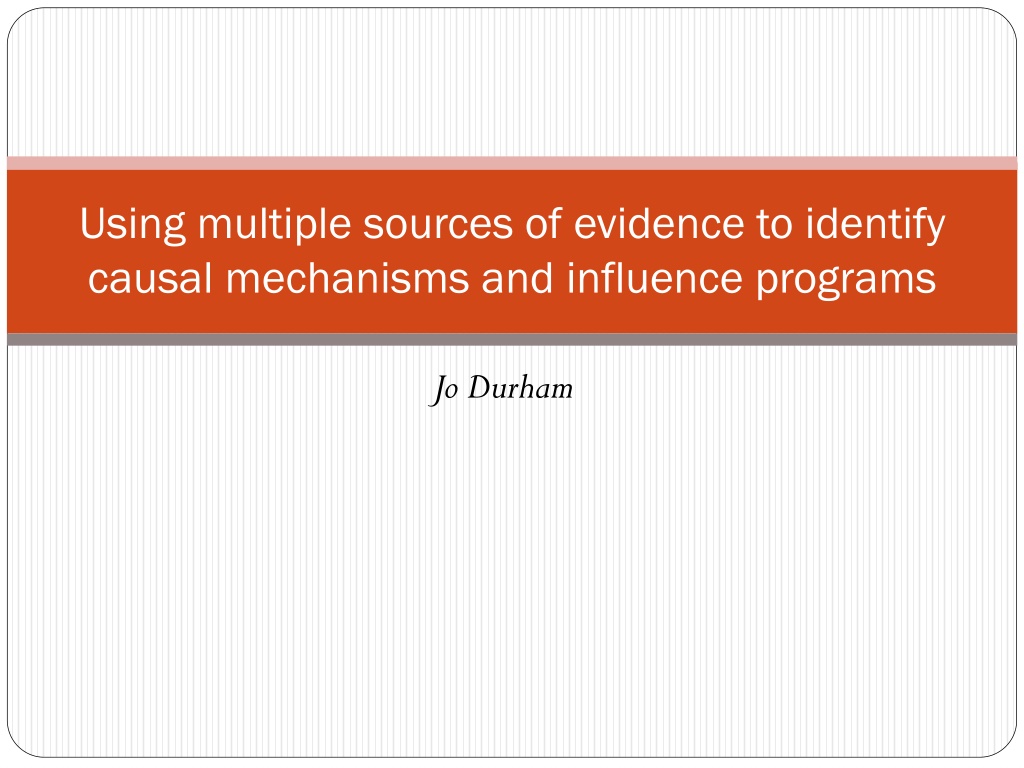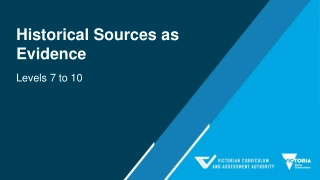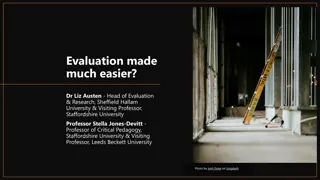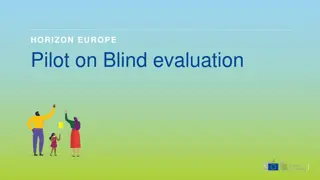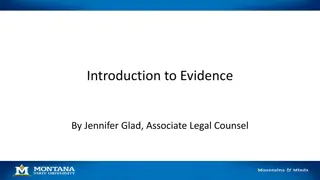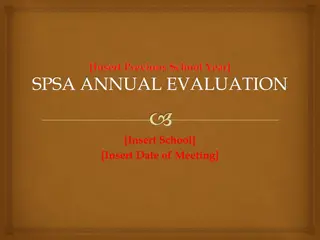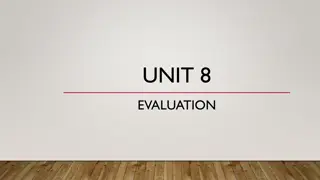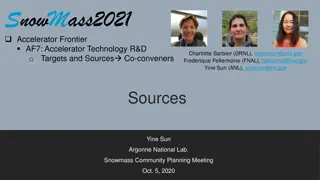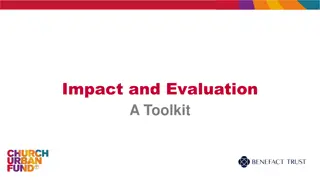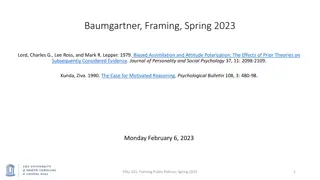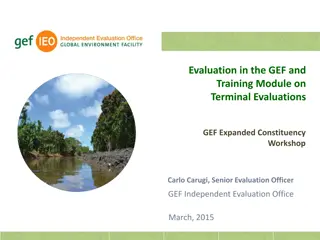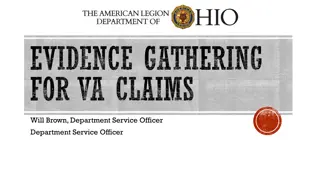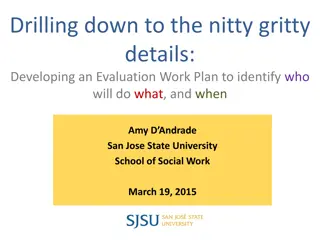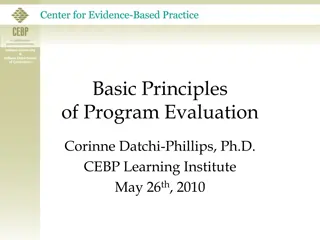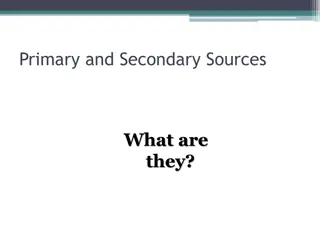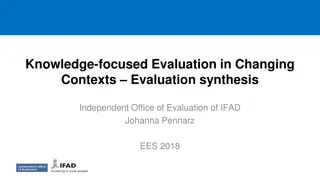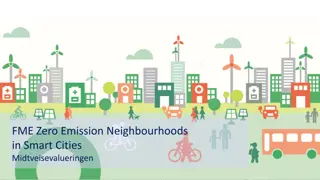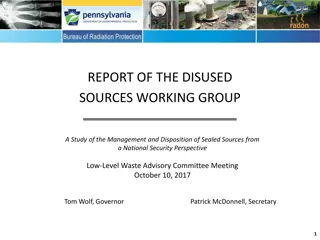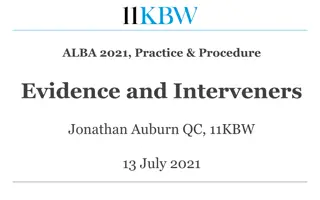Utilizing Multiple Sources of Evidence for Program Evaluation
This presentation by Jo Durham discusses the methodological framework for evaluating programs, focusing on causal mechanisms. It explores how participant reasoning and program resources combine to influence program success at different levels. The discussion also covers the impact of household livelihood strategies and contextual factors on program outcomes. A case study of the Lao PDR national program to remove unexploded ordnance further illustrates the application of these evaluation methods.
Download Presentation

Please find below an Image/Link to download the presentation.
The content on the website is provided AS IS for your information and personal use only. It may not be sold, licensed, or shared on other websites without obtaining consent from the author. Download presentation by click this link. If you encounter any issues during the download, it is possible that the publisher has removed the file from their server.
E N D
Presentation Transcript
Using multiple sources of evidence to identify causal mechanisms and influence programs Jo Durham
Presentation overview Methodological framework The evaluation The program Evaluation question Methods Evaluation results & influence Reflection on methodological framework
Methodological framework The combination of participant reasoning and program resources enables programs to work (program mechanism ) Mechanisms can work at different levels The contexts in which programs operate make a difference to the outcomes they achieve
Methodological framework Household livelihood strategies are influenced by access to livelihood resources: Skills, education, knowledge, labour, health (human) Social contacts, networks relationships (social) Safe drinking water, roads, equipment (physical) Credit, savings (finance) Land, forest, water (natural)
Methodological framework Livelihood choices and outcomes are influenced by context: Individual Family Community Program Broader community The interaction between the program, its resources, the program recipient and the context determines program recipient choice and outcomes
Lao PDR national program removes unexploded ordnance (UXO) (e.g. grenades, rockets, and cluster munitions, bombs) from contaminated land Generally remote, rural areas Mainly subsistence farmers Limited integration into cash economy Limited access to basic services Low literacy/education No pre-intervention baseline, different service providers
Unexploded ordnance (UXO)program in Unexploded ordnance (UXO)program in the Lao PDR the Lao PDR Program objective: To reduce risk of post-conflict UXO injury and contribute to poverty reduction through removing UXO contamination from community and household land
Evaluation context: Unexploded ordnance program in the Lao PDR Program activities: Survey, community engagement, identification of hazardous areas and removal and destruction of unexploded ordnance Program recipients - households /community (particular focus on the poor)
Program logic Longer term outcomes: land use contributes to improved livelihood outcomes (increased food security, access to infrastructure, health, income) Outcome: land used by community/household (farming, wells, rehabilitation/upgrade of local infrastructure Output: decontaminated land released to community /household Activities: survey, community engagement to identify contaminated areas and where UXO is poses a barrier to productive land use (focus on poor), UXO removal, post- clearance handover of land Rationale: UXO contamination restricts access to livelihood assets and prevents affected communities/households escaping poverty and achieving sustainable livelihoods
Evaluation question Who benefits, in what ways, and in what contexts are livelihoods affected by the removal of unexploded ordnance?
Hypothesis Observation, discussion practitioners, literature Revision/refine initial hypothesis Check /refine theory Data collection Mixed methods Data analysis Search for outcome patterns and context
Initial hypothesis: Two possible mechanisms (household level) 1. Engagement mechanism (before, during and post land clearance) 2. Incentive mechanism
Engagement mechanism Engagement (before UXO land clearance) - raises awareness of intervention and households request clearance Engagement (during UXO/post-UXO land clearance) recipient aware of area of land cleared, confident in the process - sense of safety and land use
Incentive mechanism UXO-free land provides an incentive for households to use the land in more effective ways to improve livelihood outcomes
Findings When does the engagement mechanism work? How? In what contexts? For who?
Engagement mechanism works when Inclusive Appropriate medium Appropriate time Sustained Source is trusted Works by raising awareness, creating interest and demand for service
Engagement mechanism works in the context of Program context Bureaucracy Organisational professionalism Demarcating users Household context Ability to understand process Time to be involved in engagement process Have labour Confident in program Social/political connections Believe will contribute to livelihood goals
Examples of when the engagement mechanism did not work Cognitive: Unaware of the service Misinformed about eligibility (e.g. not sure if had to pay, throught their land too small) Misinformed about the process thought were on the list
Examples of when the engagement mechanism did not work Household context: Low priority focus on meeting daily food requirements Low priority have strategies for managing the risk Lack of assets (e.g. labour for vegetation removal) Unable to complete forms (e.g. illiterate, embarrassed to ask for help) Easier for households with assets (labour, literacy, social/political connections, basic needs met)
Implications for program Need to strengthen engagement strategies including: Staff training for staff Multiple engagement strategies Appropriate language and medium Have and communicate clear criteria for eligibility Simple request process Monitor participation/engagement
Findings When does the incentive mechanism work? How? In what contexts? For who?
Incentive mechanism works when Believe have ability to undertake planned action Believe the planned action will contribute to livelihood goals Believe that land has been cleared of UXO to satisfactory standard
Incentive mechanism works in the context of Household context Access to assets Sense of ownership Bureaucracy (timing/engagement) Program context Bureaucracy Organisational professionalism
Examples of when the incentive mechanism did not work Cognitive: Lack of ownership (engagement?) UXO found on cleared land (quality of clearance or engagement?) No plan to change land use
Examples of when the incentive mechanism did not work Household context Increased value sold, redistributed, leased (rare) Believe do not have skills/knowledge (e.g. switch to cash crops) Unsure in effectiveness of different methods Negative past experience (e.g. grow bananas but cannot sell) Lack of access to assets (labour, skills, knowledge, literacy, equipment, seeds, markets) Low priority - focus on meeting basic needs in proven way No monitoring (policing)
Implications for program Effective engagement Work with community widen ownership Work with community increase community efficacy/diffusion of innovation Link communities with other service providers
Small cash income Mediated by policies, institutions, markets, social/cultural norms, climate Sell labour Have goods to sell & knowledge of market & believe to be beneficial Better access information, e.g. health and education Labour market & saleable skills & believe to be beneficial Buyers come into the village Effective engagement strategy before UXO clearance Aware/ interested & have assets & believe to be beneficial Request UXO land clearance & HH has labour & effective engagement Land UXO cleared & have assets & believe to be beneficial & trust quality All weather road built safely & maintained
Reflections on methodological framework Helped highlight: Who benefited Helped explain outcomes It recognised the importance of people in the evaluation Highlighted where the program could intervene Built on what program staff already knew (logical frameworks) Worked well in a context where no baseline was available
Reflections on methodological framework Qualitative methods essential in exploring mechanisms and contexts Need for language to be adapted for audience Raised issues of how different outcomes are valued & tensions between expected outcomes and reported outcomes for target group
Acknowledgements MAG (Mines Advisory Group) NRA (National Regulatory Authority for the UXO sector Lao PDR Vong Nanhthavong, Co-researcher Respondents Photos courtesy of MAG
References Pawson, R., & Tilley, N. (1997). Realistic Evaluation. London: Sage Publications. Sayer, A. (2000). Realism and Social Science. London: Sage.
